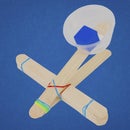Introduction: Hydraulic Bridge - Engineering Project for Kids
Real-world movable bridges sometimes use hydraulic power to assist the lifting mechanism. This hands-on engineering project mimics that engineering technique using a simple hydraulic system made from plastic syringes and tubing!
You can find the lesson plan, 1-page project sheet, and more project ideas at STEM-Inventions.com
Step 1: Gather Materials
The Engineering Creation Kithas everything you need for this project and many more from STEM Inventions.
- Hot glue gun for kids
- Glue sticks
- Syringe and tubing kit (or just the adapters)
Or bulk tubing and syringes
- Craft sticks
- 1/2" craft cubes (Bulk pack)
- Cubes with holes (Bulk pack)
- 1/8" thick dowel
- 4" cable ties
When you make a purchase through these links, I may earn an affiliate commission at zero cost to you.
Step 2: Create the Base
Start by creating a rectangle of craft sticks (picture 1). I recommend making it at least 3 sticks-long, but you could make it longer. Glue on 4 craft cubes into the corners, then another 4 cubes about 2" apart from the corners.
Create triangular supports on both ends of the base (picture 2). On one end, connect the supports with 2 more cubes and a stick. These supports will hold up the bridge, and the strong triangular shapes will easily bear its weight.
Step 3: Make the Hinged Platform
Make the hinge (picture 1): On the unconnected support, glue a cube with holes onto each support. Cut a 1/8" dowel to size, thread 2 cubes onto it, and insert the ends into the first two cubes.
Create the bridge platform structure (picture 2): Glue sticks in a rectangular pattern to create a foundation for the bridge. The platform must be attached to the two inner hinge cubes so it rotate up and down. Therefore, it will be slightly narrower than the rest of the base.
Step 4: Create the Hydraulics
The hydraulics work best when there is little to no air in the system, so follow this sequence carefully to get the best-performing bridge!
- Fill one syringe with water and attach 12" of tubing (picture 1).
- Push water through the tubing to remove all of the air (picture 2).
- Put the end of the tubing in the water, and refill the syringe to 10ml (picture 3).
- Attach a second, empty syringe, and affix one of the plastic toppers (picture 4). You're done!
Note: You can substitute a syringe topper by gluing a wood cube with holes to the syringe.
Step 5: Attach the Hydraulics
Glue a cube with holes under the platform hinge (picture 1). Affix the nozzle of the syringe that has the topper to the cube with a cable tie. Tie it tightly enough so it can't slip out, but not too tight.
Glue a stick to the center of the bridge platform (picture 2), then attach the topper to it with a cable tie.
The bridge should be able to raise about as high as shown in picture 3!
Step 6: Build the Bridge
The main bridge mechanism is done! In this project, the bridge itself is largely an embellishment, so the directions here will be minimal since you can design whatever bridge you'd like. For an unmistakable truss bridge appearance, use a regular triangular pattern, and support the structure with more craft cubes.
Want more science and engineering? Check out my Truss Bridge project idea. This lesson focuses on building, testing, and redesigning the bridge itself. You could create and test the bridge, then build the hydraulic lift mechanism for it!













